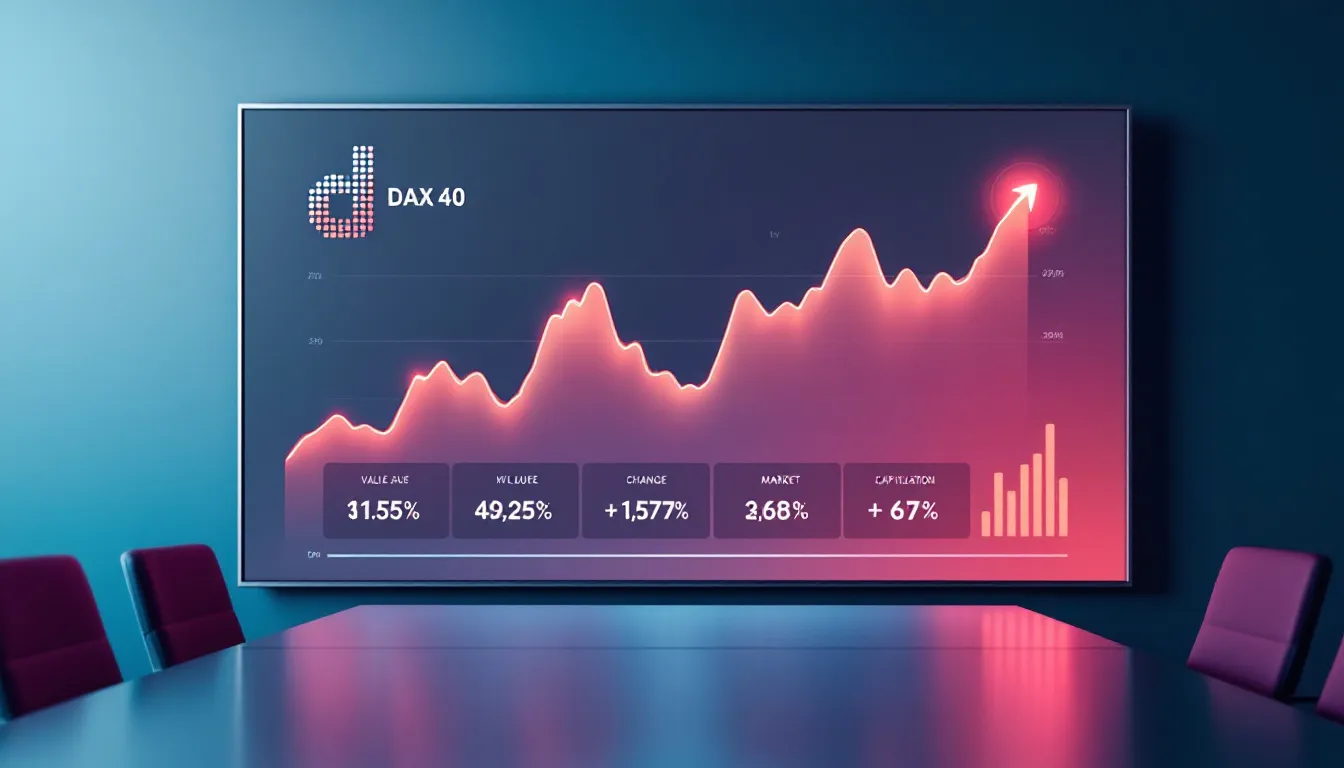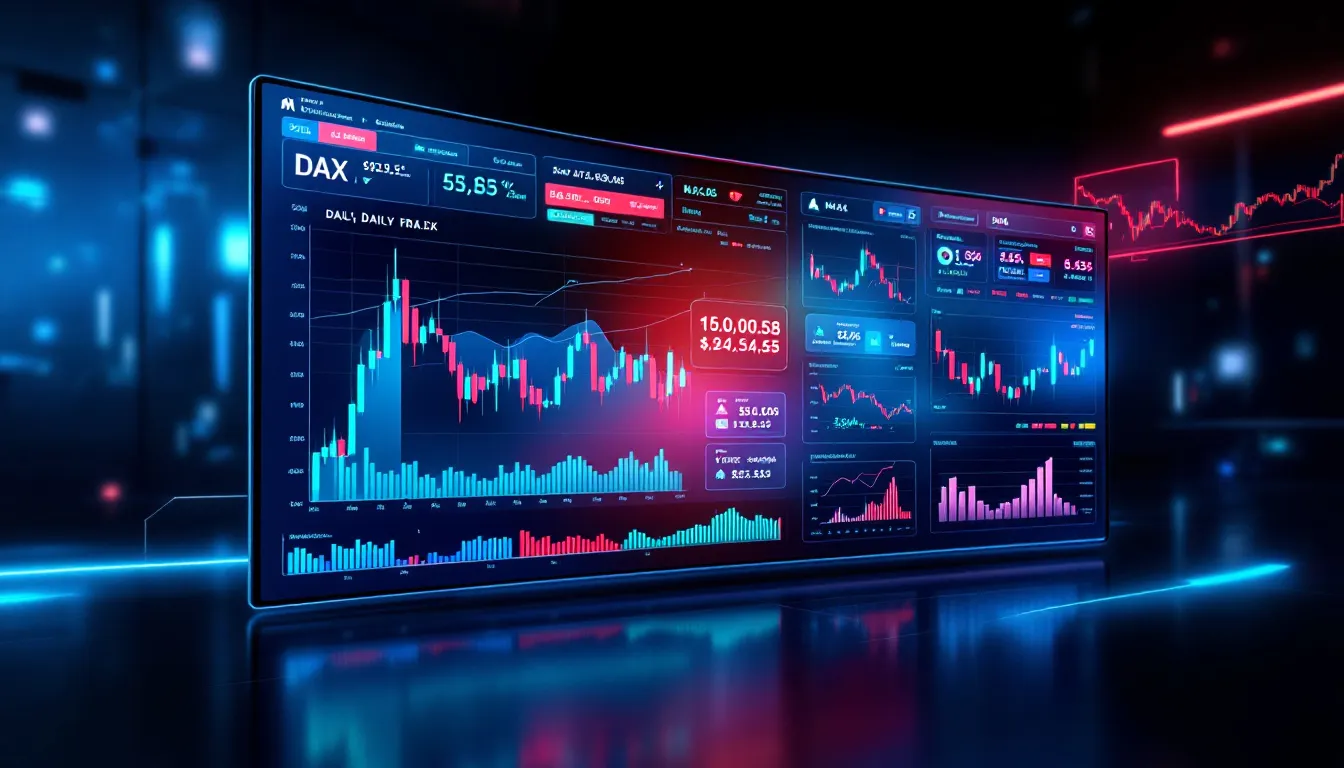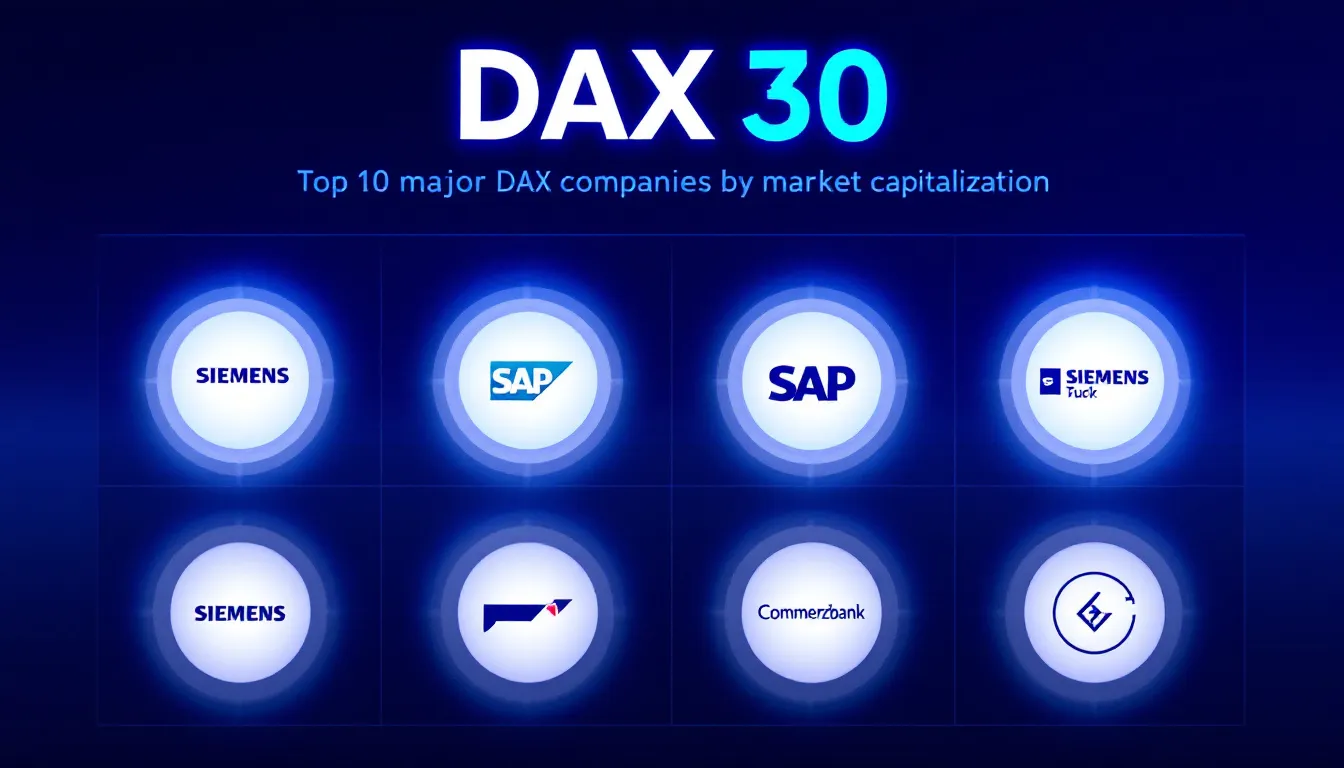Top Strategies for DAX Trading – Maximize Your Profits Today
Looking to succeed in DAX trading? This article will teach you effective strategies to trade the DAX 40 index, understand key factors influencing its performance, and discover various trading instruments. Get ready to navigate the complexities of DAX trading and maximize your profits.
Key Takeaways
- The DAX 40 is a key indicator of the German economy, comprising 40 major companies and reflecting economic health and volatility influenced by socio-political events.
- Key factors affecting DAX performance include company market capitalization, socio-political developments, and exchange rate fluctuations, with historical data indicating a strong long-term growth trend.
- Equity Index Futures Trading
- Traders can engage with the DAX 40 using various instruments like ETFs, futures, and options, while technical analysis and day trading strategies, including volume confirmation and pivot points, enhance trading effectiveness.
Understanding the DAX 40 Index

The DAX 40 is not just any stock market index; it is the pulse of the German economy. Comprising 40 major German blue-chip companies, the DAX 40 serves as a key indicator of the nation’s economic health. These companies are selected based on market capitalization and liquidity, ensuring that the stock index reflects the most significant players in the German market. The DAX 40’s importance is underscored by its substantial growth, surpassing 13,000 points before its 40th birthday, a testament to its resilience and prominence in the German stock index.
Price movements within the DAX index are a reflection of the volatility and performance of its constituent companies. These movements are often influenced by socio-political events, such as Brexit and the coronavirus pandemic, which can cause significant fluctuations. Traders must grasp these dynamics to effectively navigate the complexities of the DAX 40.
The DAX 40 is weighted by the free-float methodology, a system that considers only the shares available for trading, excluding those held by insiders. This approach ensures that the index more accurately represents market sentiment and liquidity. Focusing on the largest and most liquid companies, the DAX 40 offers a reliable snapshot of the German stock market.
Key Factors Influencing DAX Performance
The performance of the DAX 40 is influenced by a myriad of factors, each playing a crucial role in shaping the index’s trajectory. One of the primary influences is the market capitalization of the companies listed in the DAX. Larger companies have a more significant impact on the overall index, making their individual performance critical to the DAX’s movement.
Socio-political events are another major influence. Elections, geopolitical tensions, and economic policies can all affect DAX futures and the broader index. Negative news about major DAX companies can lead to sharp declines, while positive developments can boost the index.
Exchange rate fluctuations also play a significant role, as many DAX companies operate globally. Changes in the euro’s value can impact their earnings, subsequently influencing the index’s performance.
Historical performance data provides valuable insights into the DAX’s long-term trends. Over the past five years, the DAX index has recorded an average annual return of 10.9%, showcasing its robust performance. Additionally, the DAX has achieved a compound annual growth rate of approximately 8.08% over the last 50 years, indicating strong overall growth and resilience.
Traders must understand these key factors to navigate the DAX 40 effectively. Monitoring market capitalization, socio-political events, and exchange rates helps traders anticipate index movements and make informed decisions.
How to Trade DAX with ETFs and Derivatives

Trading the DAX 40 offers a variety of instruments, each with its unique advantages and risks. Among these, ETFs and derivatives like futures, options, and CFDs stand out as popular choices for traders. Leveraging these instruments can significantly enhance your trading strategy.
ETFs, or exchange-traded funds, are a convenient way to gain exposure to the DAX index. An ETF related to the DAX contains all the stocks in the index and aims to mirror its performance. This allows investors to benefit from the overall movement of the DAX without having to buy individual stocks. This passive investment strategy can provide steady returns in line with the index’s performance.
DAX futures are another powerful instrument, involving an agreement to buy or sell the index at a predetermined price on a specific date. This allows traders to speculate on the future direction of the DAX. Options grant the right to trade the DAX at a predetermined price. However, they do not impose the obligation to do so before a specified date. This flexibility can be advantageous for managing risk and capitalizing on market movements.
CFDs, or contracts for difference, are popular for their ability to offer exposure to the DAX 40 without owning the underlying assets. With CFDs, traders can take long or short positions, allowing them to profit from both rising and falling markets. Spread betting is another method, involving betting on the price movement of the DAX index. This approach can be highly speculative and carries significant risk.
Understanding these trading instruments helps traders diversify their strategies and choose options that align with their risk tolerance and market outlook. Whether you prefer the passive approach of ETFs or the active trading opportunities presented by futures, options, and CFDs, there are numerous ways to engage with the DAX 40.
Trading Hours for the DAX 40
Effective trading requires knowing the DAX 40’s trading hours. The primary trading venue for the DAX 40 is the Frankfurt Stock Exchange, where trading for equities runs from 8:00 a.m. to 10:00 p.m. CET. The opening auction for the DAX occurs at 8:50 a.m. CET, setting the stage for the trading day, while the closing auction takes place at 5:30 p.m. CET.
Extended trading hours provide additional opportunities for traders. These hours run from 8:00 to 9:00 a.m. CET and from 5:40 to 10:00 p.m. CET. For structured products, trading can continue until 10:00 p.m. CET on the Frankfurt Stock Exchange. On public holidays, trading for shares and ETPs ends at 8:00 p.m. CET on stock exchanges.
In the UK, the DAX can be traded from 7:00 a.m. to 9:00 p.m. UTC, offering a wide window for traders to engage with the index. Planning trading activities and optimizing strategies for the DAX 40 requires understanding these trading hours and regional differences.
Technical Analysis Tools for DAX Trading

Technical analysis is a cornerstone of successful DAX trading, with tools like the Relative Strength Index (RSI) and moving averages playing pivotal roles. The RSI is a popular tool used to identify overbought or oversold conditions, helping traders make informed decisions. Analyzing the RSI allows traders to take long positions when the index exceeds 75 and short positions when it falls below 25.
Moving averages are another essential tool for analyzing price trends. These averages can be customized across various timeframes, including daily and exponential moving averages, to smooth price data and identify trends. Tracking these trends helps traders better understand the DAX’s price movements and make strategic decisions.
Incorporating RSI and moving averages into technical analysis provides a comprehensive view of the DAX 40. These tools help navigate market complexities, allowing traders to refine strategies and improve success rates.
Day Trading Strategies for DAX Futures
Day trading DAX futures requires a strategic approach, especially during the first two hours of trading. Establishing a range breakout strategy during this period is essential, as it sets the tone for the rest of the trading day. Volume confirmation is crucial in validating breakout signals, ensuring that traders are making decisions based on robust data.
A trend-following strategy involves buying when the price surpasses the previous day’s high and selling when it drops below the previous day’s low. This approach leverages momentum and can be highly effective in capturing significant price movements.
Pivot points are key indicators for determining potential support and resistance levels in DAX trading. Identifying these levels enables traders to better anticipate price movements and make more informed decisions. Incorporating technical indicators like the MACD and Stochastic alongside RSI and moving averages can further enhance trading strategies and improve outcomes.
Historical Data and Price Trends
Historical data and price trends are invaluable tools for DAX traders. The DAX experienced significant volatility during the coronavirus pandemic, losing years of gains in just a few weeks. This dramatic shift highlights the importance of understanding historical price movements and their underlying causes.
Historical data analysis helps traders identify patterns and trends to inform future strategies. Examining past performance enables traders to anticipate potential price movements and make more informed decisions. This analytical approach is crucial for navigating the complexities of the DAX index and maximizing trading success.
Major DAX Companies by Market Cap

The DAX 40 is home to some of the largest and most influential companies in Germany. SAP, the largest company in the DAX 40, boasts a market capitalization of over $200 billion. Siemens follows closely with a market capitalization of approximately $185.63 billion, making it a significant contributor to the index.
Deutsche Telekom ranks third with a market cap of around $176.87 billion, while Allianz SE is fifth with approximately $132.61 billion. Munich RE and Airbus, despite being based in the Netherlands, also feature prominently in the DAX with market capitalizations of $74.40 billion and $142.23 billion, respectively.
Mercedes-Benz, Merck KGaA, and Porsche are other notable companies in the DAX 40, each contributing significantly to the index’s overall market capitalization. Grasping these major players and their market dynamics is crucial for effectively navigating the DAX.
Impact of Global Markets on the DAX

The DAX index’s performance is increasingly influenced by global economic trends rather than just the German economy. The index often mirrors movements in major European and U.S. indices, reflecting similar trends. This correlation underscores the importance of monitoring global markets when trading the DAX.
The DAX shows a stronger correlation with global GDP growth (0.41) compared to German GDP growth (0.33), highlighting its global operational reach and the significance of international market trends. About 20% of the revenues of DAX companies come from their domestic market, with the rest generated globally, further emphasizing the index’s dependence on international economic conditions.
Traders must understand the impact of global markets on the DAX. Monitoring global economic trends and major indices helps traders better anticipate DAX movements and make more informed decisions.
Summary
In summary, mastering DAX trading requires a deep understanding of the index, the key factors influencing its performance, and the various trading instruments available. By leveraging technical analysis tools, historical data, and day trading strategies, traders can navigate the complexities of the DAX 40 and maximize their profits.
The DAX 40, with its major German companies and global reach, offers numerous opportunities for traders. By staying informed about global market trends and understanding the dynamics of the DAX, traders can make strategic decisions that lead to success. So, equip yourself with these strategies and embark on your DAX trading journey with confidence.
Frequently Asked Questions
What is the DAX 40 Index?
The DAX 40 Index is a significant stock market index comprising 40 major German blue-chip companies, reflecting the performance of the German economy. It utilizes a market capitalization and liquidity-weighted approach, adopting a free-float methodology.
How do socio-political events affect the DAX 40?
Socio-political events like elections and geopolitical tensions can greatly influence the DAX 40, causing sharp declines with negative news or increases with positive developments. Investors should stay informed about these factors to make better trading decisions.
What are the different trading instruments available for the DAX 40?
The DAX 40 can be traded using various instruments such as CFDs, spread betting, futures, options, and ETFs, each offering distinct advantages and risks. Selecting the right instrument is essential to align with your trading strategy and goals.
What are the trading hours for the DAX 40?
The DAX 40 trades on the Frankfurt Stock Exchange from 8:00 a.m. to 10:00 p.m. CET, with regular trading hours from 9:00 a.m. to 5:30 p.m. CET. Extended trading hours are available before and after these times.
How do global markets influence the DAX 40?
The DAX 40 is heavily influenced by global economic trends, often reflecting movements in major European and U.S. indices. Its performance is more closely tied to overall global GDP growth than to Germany’s domestic economic indicators.
